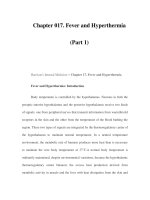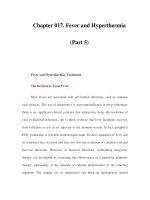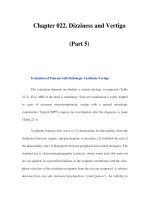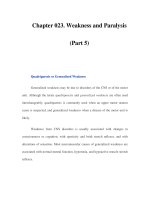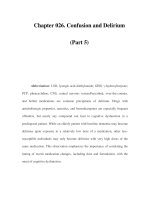Chapter 046. Sodium and Water (Part 5) docx
Bạn đang xem bản rút gọn của tài liệu. Xem và tải ngay bản đầy đủ của tài liệu tại đây (14.09 KB, 6 trang )
Chapter 046. Sodium and Water
(Part 5)
Hypovolemia: Treatment
The therapeutic goals are to restore normovolemia with fluid similar in
composition to that lost and to replace ongoing losses. Symptoms and signs,
including weight loss, can help estimate the degree of volume contraction and
should also be monitored to assess response to treatment. Mild volume contraction
can usually be corrected via the oral route. More severe hypovolemia requires
intravenous therapy. Isotonic or normal saline (0.9% NaCl or 154 mmol/L Na
+
) is
the solution of choice in normonatremic and most hyponatremic individuals and
should be administered initially in patients with hypotension or shock.
Hypernatremia reflects a proportionally greater deficit of water than Na
+
, and its
correction will therefore require a hypotonic solution such as half-normal saline
(0.45% NaCl or 77 mmol/L Na
+
) or 5% dextrose in water. Patients with significant
hemorrhage, anemia, or intravascular volume depletion may require blood
transfusion or colloid-containing solutions (albumin, dextran). Hypokalemia may
be present initially or may ensue as a result of increased urinary K
+
excretion; it
should be corrected by adding appropriate amounts of KCl to replacement
solutions.
Hyponatremia
Etiology
A plasma Na
+
concentration <135 mmol/L usually reflects a hypotonic
state. However, plasma osmolality may be normal or increased in some cases of
hyponatremia. Isotonic or slightly hypotonic hyponatremia may complicate
transurethral resection of the prostate or bladder because large volumes of
isoosmotic (mannitol) or hypoosmotic (sorbitol or glycine) bladder irrigation
solution can be absorbed and result in a dilutional hyponatremia. The metabolism
of sorbitol and glycine to CO
2
and water may lead to hypotonicity if the
accumulated fluid and solutes are not rapidly excreted. Hypertonic hyponatremia
is usually due to hyperglycemia or, occasionally, intravenous administration of
mannitol. Relative insulin deficiency causes myocytes to become impermeable to
glucose. Therefore, during poorly controlled diabetes mellitus, glucose is an
effective osmole and draws water from muscle cells, resulting in hyponatremia.
Plasma Na
+
concentration falls by 1.4 mmol/L for every 100 mg/dL rise in the
plasma glucose concentration.
Most causes of hyponatremia are associated with a low plasma osmolality
(Table 46-2). In general, hypotonic hyponatremia is due either to a primary water
gain (and secondary Na
+
loss) or a primary Na
+
loss (and secondary water gain). In
the absence of water intake or hypotonic fluid replacement, hyponatremia is
usually associated with hypovolemic shock due to a profound sodium deficit and
transcellular water shift. Contraction of the ECF volume stimulates thirst and AVP
secretion. The increased water ingestion and impaired renal excretion result in
hyponatremia. It is important to note that diuretic-induced hyponatremia is almost
always due to thiazide diuretics. Loop diuretics decrease the tonicity of the
medullary interstitium and impair maximal urinary concentrating capacity. This
limits the ability of AVP to promote water retention. In contrast, thiazide diuretics
lead to Na
+
and K
+
depletion and AVP-mediated water retention. Hyponatremia
can also occur by a process of desalination. This occurs when the urine tonicity
(the sum of the concentrations of Na
+
and K
+
) exceeds that of administered
intravenous fluids (including isotonic saline). This accounts for some cases of
acute postoperative hyponatremia and cerebral salt wasting after neurosurgery.
Table 46-2 Causes of Hyponatremia
I. Pseudohyponatremia
A. Normal plasma osmolality
1. Hyperlipidemia
2. Hyperproteinemia
3. Posttransurethral resection of prostate/bladder tumor
B. Increased plasma osmolality
1. Hyperglycemia
2. Mannitol
II. Hypoosmolal hyponatremia
A. Primary Na
+
loss (secondary water gain)
1. Integumentary loss: sweating, burns
2. Gastrointestinal loss: vomiting, tube drainage,
fistula, obstruction, diarrhea
3. Renal loss: diuretics, osmotic diuresis,
hypoaldosteronism, salt-
wasting nephropathy,
postobstructive diuresis, nonoliguric acute tubular
necrosis
B. Primary water gain (secondary Na
+
loss)
1. Primary polydipsia
2. Decreased solute intake (e.g., beer potomania)
3. AVP release due to pain, nausea, drugs
4. Syndrome of inappropriate AVP secretion
5. Glucocorticoid deficiency
6. Hypothyroidism
7. Chronic renal insufficiency
C. Primary Na
+
gain (exceeded by secondary water gain)
1. Heart failure
2. Hepatic cirrhosis
3. Nephrotic syndrome
